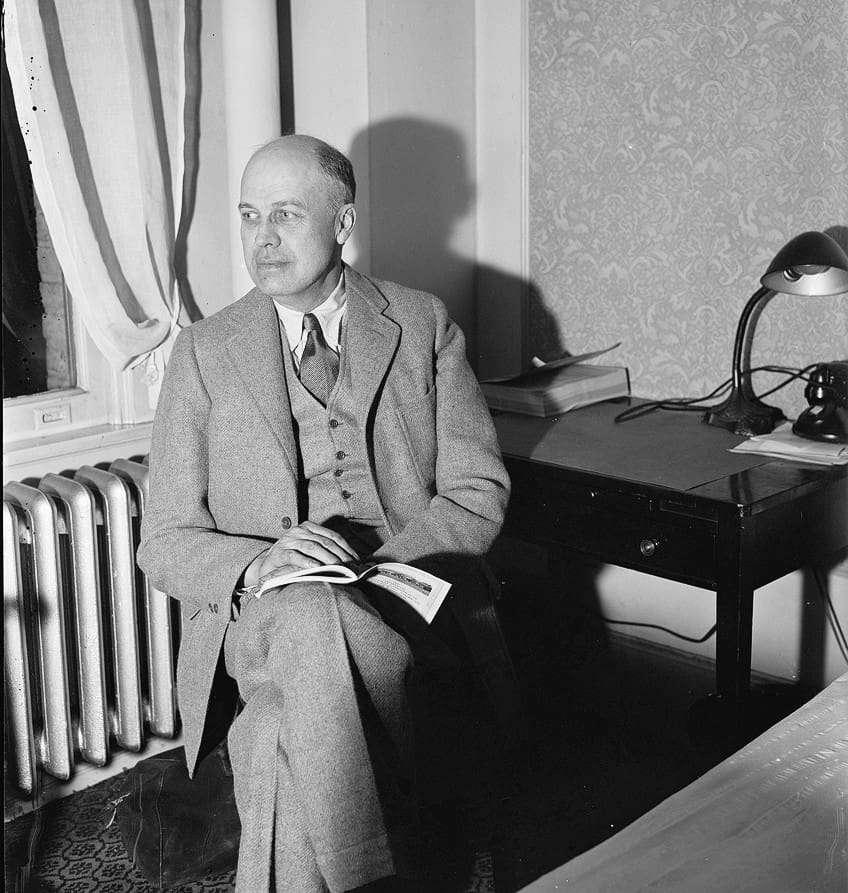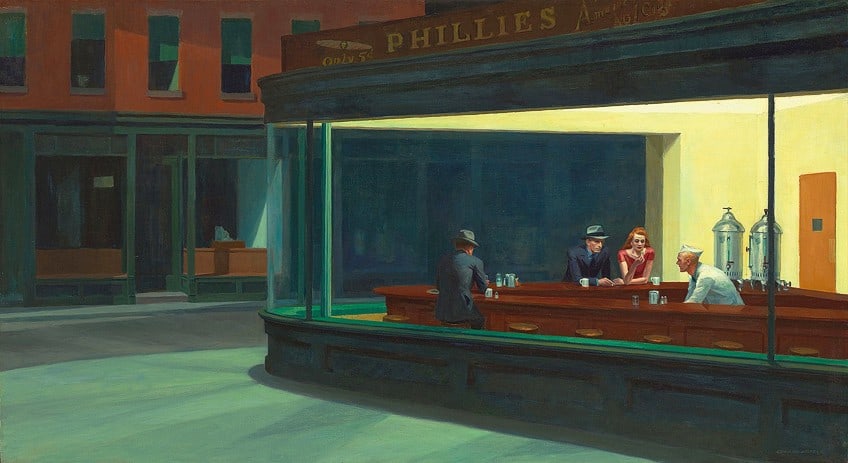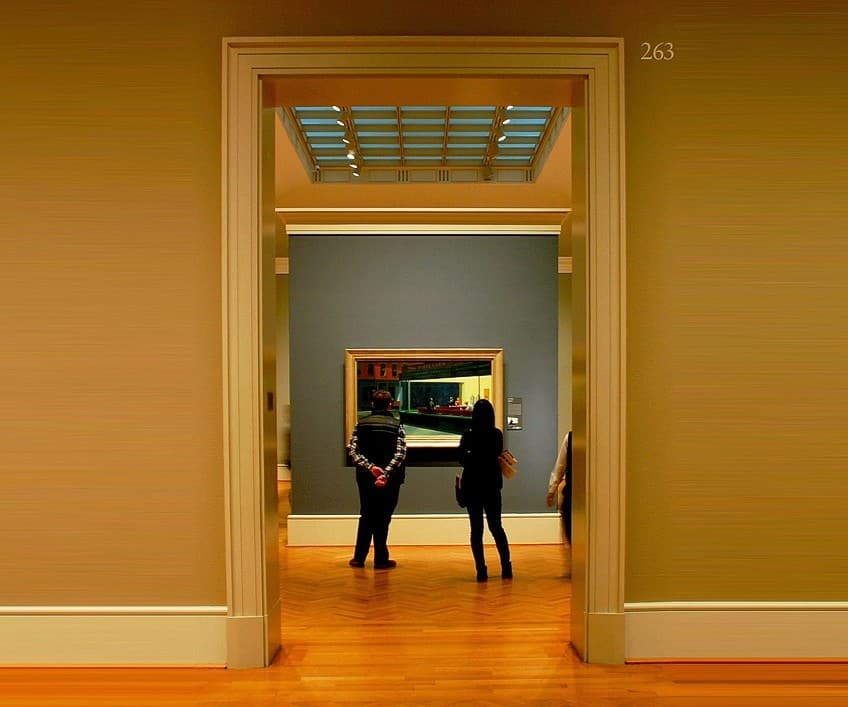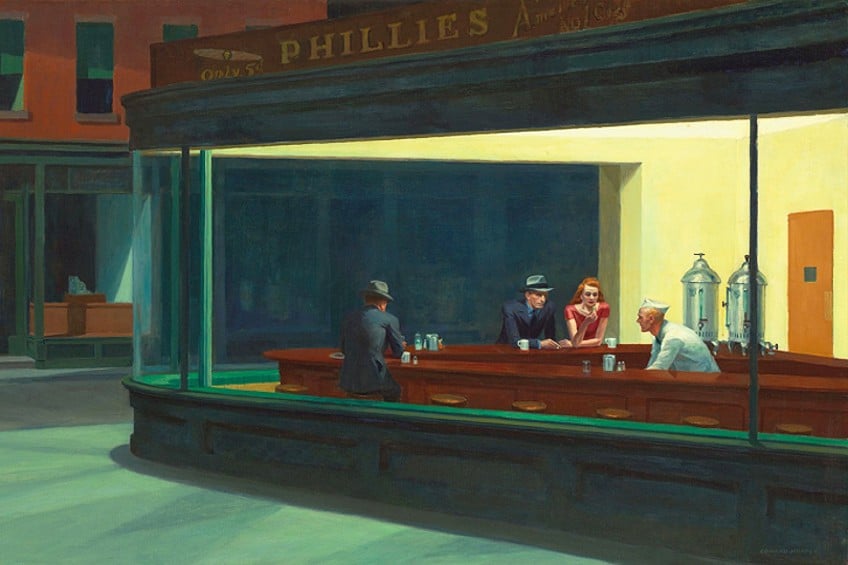“Nighthawks” by Edward Hopper – Discover the Famous Diner
The Nighthawks painting by Edward Hopper is a highly renowned oil on canvas painting produced in 1942. Nighthawks by Edward Hopper depicts four individuals in a late-night downtown diner and is regarded as the artist’s most significant artwork. The Nighthawks painting’s value was $3,000 when it was sold to the Art Institute of Chicago a few months after it was completed. Let’s find out what made this painting so renowned!
Contents
Understanding Nighthawks by Edward Hopper
Many believe that Edward Hopper was significantly inspired by one of Ernest Hemingway’s short stories, either The Killers, which was published in 1927, or the 1933 philosophical piece A Clean, Well-Lighted Place. Many people have expressed that the painting exudes a feeling of emptiness or loneliness, to which the artist replied that it was not his conscious intention, but that perhaps it had unconsciously depicted the sense of loneliness experienced in large cities.
Before we delve any deeper into Hopper’s Nighthawks painting, we shall first begin with a brief introduction to the artist himself, Edward Hopper.
A Brief Introduction to Edward Hopper
| Artist Name | Edward Hopper |
| Nationality | American |
| Date of Birth | 22 July 1882 |
| Date of Death | 15 May 1967 |
| Place of Birth | Nyack, New York, United States |
Edward Hopper was renowned for his realistic and contemplative works that depicted the feelings of isolation and alienation of the modern lifestyle. Hopper was born in Nyack, New York, and went to the New York School of Art, where he was educated by Robert Henri and William Merritt Chase. Edward Hopper was influenced by both European and American art styles such as Impressionism, Realism, and the Ashcan School, in addition to his travels and experiences while residing in Europe. He was captivated by the works of Edgar Degas, Édouard Manet, and Winslow Homer in particular.
Strong composition, meticulous use of lighting and shadows, and a feeling of psychological tension defined Hopper’s artistic style. His works usually portray solitary individuals in both inner-city or rural locations, with sparse, emotive elements implying a narrative or atmosphere.
Hopper was a reclusive and introverted individual, and his paintings have been regarded as expressing his own feeling of separation and estrangement from the society around him. Despite his reclusiveness, his artwork had a major impact on American artists and society in general, and it is still admired for its austere, melancholy beauty and capacity to examine the complex nuances of modern life. This, however, was not the only theme that his works explored and he was equally known for his depictions of seascapes. His seascapes are divided into three categories: pure landscapes with ocean, rocks, and beach grass; sailboats; and lighthouses.

He occasionally blended these components. He was not interested in cyclical color changes, or winter or rainy landscapes, and preferred depicting pleasant weather in the majority of these pieces. The people in his paintings frequently include individuals, couples, or groups, and focus on the complex interactions between people and their surroundings. Seclusion, boredom, regret, and resignation are his core emotional themes. Hopper conveys his sentiments in a variety of settings, including public places, offices, apartments, roadway scenes, and people on vacation.
He set up his subjects as though he were taking stills for a movie or tableaux in a play, either before or right after the height of the action.
The Famous Nighthawks Painting by Edward Hopper
| Artist | Edward Hopper (1882 – 1967) |
| Date Completed | 1942 |
| Medium | Oil on canvas |
| Dimensions (cm) | 84 x 152 |
| Current Location | Art Institute of Chicago, Illinois, United States |
No artist has ever managed to capture the solitude of a contemporary city dweller like Edward Hopper, revealing the dark side of human nature. He once stated that excellent art is the external manifestation of the creator’s inner existence and that this inner life results in his particular worldview. This personal and perceptive technique is most seen in his celebrated Nighthawks painting, a piece that helped define the Modernism style. Nighthawks is regarded as the embodiment of existential art, expressing the detachment and isolation that characterizes modern urban life.
The Nighthawks painting is the most sought-after artwork in the Art Institute of Chicago’s collection, as well as one of the most identifiable works of 20th-century American art.

The History of Nighthawks by Edward Hopper
Edward Hopper’s works are smooth, clear, and considerably lifelike. He was a tenacious realist throughout the growth of a number of abstract movements. His works, which are always subdued and subtly provocative, encourage the observer to explore the piece’s narrative. Hopper highlighted the loneliness of modernity by portraying people who were typically alone and detached from their surroundings. Edward Hopper set the stage for Abstract Expressionism by emphasizing the psychological thoughts and feelings of his subjects.
Edward Hopper’s wife, Josephine, wrote in her journal that Nighthawks was finally completed on the 21st of January, 1942 in New York, only weeks after the attack on Pearl Harbour. As a result, the piece is sometimes regarded as a reflection of wartime detachment.
At this tumultuous period in our history, when everybody was fearful of another bombing, New York staged continual blackout exercises to conceal the city in absolute darkness in the event of another aerial assault. The lights in Hopper’s studio remained on through the entire drill. His wife wrote in her journal, “Edward absolutely does not take the slightest interest in the very possible potential of being bombed”. In January 1942, she wrote to Hopper’s sister regarding the new work, writing, “Edward has just produced a beautiful painting of a diner at night with three characters. Nighthawks is a wonderful name for it. In a mirror, Edward posed for the two men in the paintings, and I for the girl. He had been busy with it for approximately a month and a half “.

Nighthawks by Edward Hopper actually features four figures – a lady and three gentlemen – sitting in a minimally furnished restaurant late at night. A solitary source of light illuminates the restaurant’s interior and pours out onto a deserted street where life seems to have come to a complete halt. None of the four people interact with one another, making their relationships rather ambiguous. The artwork conveys a realization that everyone is alone in the world, with figures looking detached from one another and the observer.
The painting’s simple composition, dramatic lighting, and stillness allow the observer to easily imagine himself or herself in the scenario. The diner itself is the primary character of the piece, with strong diagonal lines emphasized by the countertop and the seats.
But, because there are no doors to enter, the observer is cut off from the scene by a continuous wedge of glass, letting the observer only see the diner’s inner world, but not engage with it, further adding to the feeling of alienation. Hopper sets the stage for events that do not appear to have occurred yet, much as in a classic film noir. This artwork, with its open-ended storyline, illustrates his focus on topics such as alienation, voyeurism, loneliness, and ambiguous connections.
Composition and Lighting
Buildings in Hopper’s works are frequently positioned at an angle to indicate that his characters exist both behind and in front of the windows. Glasses in the windows appear to be non-existent, indicating that the interior can be penetrated by sight and creating a divide between the interior and exterior worlds. This technique is also seen in Nighthawks, where the big window provides an implied boundary between the observer and the characters within.
Hopper can present the individuals in a combination of profile and frontal perspectives because of the angle at which the restaurant is oriented in the corner of the canvas.

Hopper was concerned with lighting and the colors it cast on buildings and individuals through windows. In the Nighthawks painting, a yellowish fluorescent light replaces the sun, highlighting his awareness of the expressive potential of light acting on simple shapes. The single light in the diner, which illuminates the artwork, flows out into the night through all of the windows and onto both sides of the street. Several of the surfaces in the diner become reflective as a result of the light, which wouldn’t be seen in daylight. The billboard above the café promoting $5 cigars and the cash register visible through one of the windows imply a typical American everyday experience.
The Nighthawks painting’s atmosphere is quiet and still, emphasizing the deep sense of solitude.
A Timeless Work
Just a few months after the painting was completed, the director of the Art Institute of Chicago, Daniel Catton Rich, pronounced it to be “as excellent as Homer, referring to the renowned American landscape artist from the 19th century. Rich bought the painting for $3000 for the institute, where it presently hangs. The canvas has an ageless, universal aspect that transcends its specific setting, with its well-crafted composition, absence of story, and abstracted, planes of color, making it a medium onto which one may project one’s own experience – the beauty of the painting is found in its intrinsic universality.
The artwork, an iconic piece of Americana, also has the capacity to induce nostalgia for a bygone America.

Yet, Nighthawks by Edward Hopper is still important today as a nuanced indictment of contemporary society, the reality in which we all exist, with an overpowering sense of isolation and a profound yearning, but ultimately incapacity, to connect with people around us.
History of Ownership
As Hopper finished the canvas in late winter 1942, he displayed it at Rehn’s, the gallery where his works were regularly sold. It was there for around a month. On the 17th of March, Edward and Jo Hopper attended the premiere of an exhibition of Henri Rousseau’s works at the Museum of Modern Art in New York, which had been arranged by the director of the Art Institute of Chicago. Rich was present at the exhibition, as was the director of the Museum of Modern Art, Alfred Barr.
He had gushed over Gas (1941), which Hopper had created a year before, and Jo Hopper told him he needed to make his way to Rehn’s to see the Nighthawks painting in person.
Location of the Diner in the Nighthawks Painting
The scene in the artwork was apparently modeled on a restaurant in Greenwich Village, Hopper’s Manhattan neighborhood. According to the artist, the artwork was inspired by a diner on Greenwich Avenue, where two streets intersect. He also mentioned that he simplified the scene in his painting and made the diner larger. The remark has prompted Hopper enthusiasts to look for the actual diner’s location. One of these searchers’ blogs summarized the inspiration for the quest. According to the blogger, “it’s exceedingly tough to let go of the illusion that the Nighthawks restaurant was a genuine diner, rather than an elaborate composite composed of grocery shops, hamburger establishments, and bakeries all stitched together in the artist’s mind”.
Mulry Square, located at the crossroads of West 11th Street and Seventh Avenue South is typically associated with the location of the diner.

It is roughly seven blocks to the west of Hopper’s Washington Square studio. According to a New York Times article, it can’t be the location of the eatery that prompted the artwork since a gas station occupied that site from the 1930s through the 1970s. Moss discovered a land-use plan in a municipal atlas from the 1950s that showed “a new restaurant arose near Mulry Square somewhere between the late 1930s and early 1950s.” The diner was specifically situated to the right of the filling station, on the southwestern side” Moss’ blog has a map that is not replicated in the Times piece.
In summary, there was probably never a single real-life scene similar to the one depicted by Hopper, and if one did actually exist, there is no longer enough evidence to pinpoint its particular location. “The final truth remains sadly out of grasp”, Moss writes.
References to the Nighthawks Painting in Popular Culture
Since it is so well-known, the diner scene has inspired numerous parodies and homages. Numerous artists have created works in response to or in reference to Nighthawks by Edward Hopper. It has also been referenced in literature, film, and music.
Sculpture and Painting
Hopper inspired the late 1960s and early 1970s Photorealists, notably Ralph Goings, who echoed the subject of the artwork in numerous paintings of restaurants. People’s Flowers (1971) by Richard Estes depicts a corner store in the daytime, with the shop’s wide window mirroring the sky and street. In the 1970s, more direct graphic quotes started appearing. Boulevard of Broken Dreams (1984) by Gottfried Helnwein substitutes the three customers with American icons Marilyn Monroe, Humphrey Bogart, and James Dean, featuring Elvis Presley as the diner’s attendant.
According to Gail Levin, a Hopper researcher, Helnwein associated Nighthawks‘ dark atmosphere with 1950s American movies and “the terrible destiny of the decade’s best-loved personalities.”
Red Grooms’ 1980 satire Nighthawks Revisited clogs the streetscape with humans, animals, and garbage. A Banksy spoof from 2005 depicts a big, shirtless football hooligan in Union Flag underwear standing intoxicated outside the cafe, presumably after smashing the diner’s window with a chair. A massive mural reproduction of the picture was painted on the side of a former Chinese establishment in Santa Rosa, California until it was removed in 2019.
Literature
A number of writers have speculated on how the diners in the painting ended there at a restaurant at night, as well as what would happen next. In the poem Nighthawks: After Edward Hopper’s Picture, by Wolf Wondratschek, the man and lady seated at the restaurant are portrayed as an estranged pair. In her poem, Edward Hopper’s Nighthawks, 1942, Joyce Carol Oates constructed internal monologues for the individuals in the artwork. A special edition of Der Spiegel offered five mini dramatizations based on the artwork, each with a distinct narrative; one, by playwright Christoph Schlingensief, transformed the scenario into a chainsaw slaughter.
This picture inspired short tales by Erik Jendresen, Michael Connelly, and Stuart Dybek.
Film
Hopper was an ardent moviegoer, and reviewers have found similarities between his works and film stills. Nighthawks and other works foreshadow the aesthetic of film noir, which Hopper may have impacted in its development. Hopper had a major impact on the cinema musical, Pennies from Heaven (1981), for which Ken Adam, the production designer, rebuilt the setting of Nighthawks. In the movie The End of Violence (1997), director Wim Wenders reproduced Nighthawks as the setting for a film-within-a-film. He argued that filmmakers like Hopper’s works because you can always identify where the camera would be if it were a photo. In Glengarry Glen Ross (1992), the film’s two protagonists visit a diner-style café in a sequence that depicts their loneliness and sorrow.
The picture was also briefly utilized as a background for a sequence in filmmaker Ralph Bakshi’s animated feature Heavy Traffic (1973). The “future noir” style of the science fiction movie Blade Runner (1982) was similarly influenced by the painting.
Director Ridley Scott stated, “I was continuously waving a print of this artwork up the noses of the film crew to demonstrate the look and feel I was attempting”. Roger Ebert observed in his analysis of the film Dark City (1998) that it contained storefront windows that owed something to Edward Hopper’s Nighthawks.
Another film, Hard Candy (2005) paid a similar tribute by having one scene take place in a Nighthawks Diner where a character buys a T-shirt with the words “Nighthawks” emblazoned on it. In an episode of That ’70s Show, the Formans return to their favorite diner after a fruitless attempt to eat at a nice restaurant. The cameraman pulls back to reveal that they are the couple seated at the table in the artwork after Kitty notes that the scene looks familiar. Nighthawks inspired the ending scene of TCM Open All Night entrance sequence, which was used to introduce overnight movie shows from 1994 until 2021.
The Nighthawks artwork appears in an episode of the American television series Shameless, as one of the main characters, Frank, pulls off his final robbery.
Parodies
In popular culture, the Nighthawks painting has often been parodied. It has appeared on T-shirts, posters, greeting cards, and in comic books and ads. Usually, these parodies – such as Helnwein’s Boulevard of Broken Dreams, which later became a popular poster – keep the look of the diner and the instantly recognizable angled composition but substitute the customers and the worker with other personalities.
One Nighthawks parody even spawned its own parody.
Window Shopping (1989), by Michael Bedard, is part of his Sitting Ducks line of posters that substitutes the humans in the cafe with ducks, with an alligator outside closely watching the ducks in expectation. In Poverino Peppino’s Boulevard of Broken Ducks (1993), a satisfied alligator sits on the countertop as four ducks wait outside in the rain.
The eerie image in Nighthawks by Edward Hopper has captivated viewers’ attention, creating intrigue and curiosity around the unidentified people who all appear to be strangers. The restaurant is apparently based on a street in Greenwich Village; however, an examination of the specific site of the artwork has revealed that the painting depicts an assortment of inner-city diners rather than an actual location. The artwork’s ageless and ambiguous background suggests that it could reflect any lonely modern city center. Whether based on an actual diner or not, the scene has resonated with many people through the years due to its subject matter, which has just become more relevant over time.
Frequently Asked Questions
What Is the Nighthawk Painting’s Value?
When the painting was bought in 1942, it was acquired for $3,000. That might not seem like much to pay for such a famous artwork, but today, that same amount of money would be the equivalent of $43,200. Of course, the cultural value of the painting is immeasurable.
Why Is the Nighthawks Painting So Famous?
First off, it is aesthetically very appealing. Yet, it is probably the subject matter that speaks most to those who view it. Everyone can relate to the sense of isolation and alienation experienced when in a large city during a quiet part of the night.
Jordan Anthony is a Cape Town-based film photographer, curator, and arts writer. She holds a Bachelor of Art in Fine Arts from the University of the Witwatersrand, Johannesburg, where she explored themes like healing, identity, dreams, and intuitive creation in her Contemporary art practice. Jordan has collaborated with various local art institutions, including the KZNSA Gallery in Durban, the Turbine Art Fair, and the Wits Art Museum. Her photography focuses on abstract color manipulations, portraiture, candid shots, and urban landscapes. She’s intrigued by philosophy, memory, and esotericism, drawing inspiration from Surrealism, Fluxus, and ancient civilizations, as well as childhood influences and found objects. Jordan is working for artfilemagazine since 2022 and writes blog posts about art history and photography.
Learn more about Jordan Anthony and about us.
Cite this Article
Jordan, Anthony, ““Nighthawks” by Edward Hopper – Discover the Famous Diner.” artfilemagazine – Your Online Art Source. May 3, 2023. URL: https://artfilemagazine.com/nighthawks-by-edward-hopper/
Anthony, J. (2023, 3 May). “Nighthawks” by Edward Hopper – Discover the Famous Diner. artfilemagazine – Your Online Art Source. https://artfilemagazine.com/nighthawks-by-edward-hopper/
Anthony, Jordan. ““Nighthawks” by Edward Hopper – Discover the Famous Diner.” artfilemagazine – Your Online Art Source, May 3, 2023. https://artfilemagazine.com/nighthawks-by-edward-hopper/.



